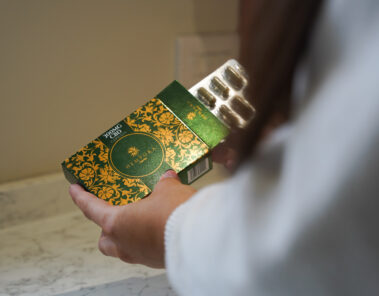Learn about CBD with our must-read exclusive CBD guide booklet!
• The bodies endocannabinoid system and how it works
• What are CBD, cannabinoids and terpenes?
• What are the differences between CBD products?
• What makes a quality CBD oil & CBD product?
• How much CBD should I take?
Free Hempura CBD Dosage Calendar / Chart
A history of hemp
Hemp is a strain of the Cannabis Sativa plant that has been used for thousands of years as a food product (the seeds are edible and can be used to make nutritionally rich vegetable oil, the dried flowers and leaves can be used in tea, etc. [1]), for creating fabrics and building materials, and for its health and wellbeing properties.
The Cannabis Sativa plant is already widely used in the health and beauty industry. Oil from hemp seeds is used in a variety of products, including lotions and oils for skin and hair care. The vital nutrients and essential fatty acid (EFA) content in hemp seed oil make it an excellent moisturiser, and therefore a popular product to help with dry skin conditions such as eczema and psoriasis.
The cellulose fibres of the industrial hemp plant are also widely used in the manufacture of clothing, bags and even building materials, and have been for hundreds – if not thousands – of years. In fact, evidence of hemp-based fabric was found in Turkey in the ancient city of Çatalhöyük, dating back 9000 years. [2]
The use of industrial hemp for its health and wellbeing properties is also long documented – with written evidence of its use in Greek and Roman times, and mention of it being used by the physician Hoa-tho in China in 200 A.D. [3]
In the last 50 years, more and more scientific research has been carried out into the unique properties of Industrial Hemp, with the psychoactive chemical tetrahydrocannabinol (THC) first identified and isolated by Dr Raphael Mechoulam [4] in 1964. CBD, or Cannabidiol, another of the chemicals present in Cannabis Sativa (one of more than 60 cannabinoid compounds found in industrial hemp [5]) was isolated and identified in 1963 [6], and the wellbeing and therapeutic benefits of this particular cannabinoid are still being researched and uncovered today.
Unlike the psychoactive variants of the Cannabis Sativa plant (which are high in the compound THC), Industrial Hemp has an extremely low THC content but contains Cannabidiol (CBD) as well as a range of other beneficial cannabinoids and terpenes which can help to promote wellbeing.
Introducing the Endocannabinoid System.
In order to understand what CBD does, we need to first take a look at the Endocannabinoid System (ECS).
The endocannabinoid system, first identified in the late 1980s by Allyn Howlett and William Devane [7], has been described as ‘an important modulatory system in the function of the brain, endocrine and immune tissues… (which) play(s) a very important role in the secretion of hormones related to reproductive functions and response to stress’ [8].
A properly functioning endocannabinoid system is essential, as it serves the purpose of helping cells maintain optimum performance, and it has been an important part of our physiology for hundreds of thousands of years; cannabinoid receptors have even been identified in a ‘sea squirt’ [9], an invertebrate that evolved over 600 million years ago.
- Endocannabinoids are molecules produced naturally by the body to support the endocannabinoid system, and these molecules have a number of striking similarities with phytocannabinoids – the chemicals found in Cannabis Sativa.
- Phytocannabinoids (like CBD) can bind to certain cannabinoid receptors in the endocannabinoid system [10] and help promote improved wellbeing
CBD – just one of a number of beneficial chemicals in the Cannabis Sativa!
As we mentioned earlier, CBD is just one of a large number of cannabinoids found in industrial hemp. Other cannabinoids include cannabidiolic acid (CBDA) [11], cannabichromene (CBC), cannabidivarin (CBDV), and a number of other compounds called terpenes.
Terpenes are a large and diverse class of organic compounds that are produced by a variety of plants – including hops, which is used as a flavouring component in brewing [12]. They are incredibly fragrant and are what gives cannabis it’s aromatic diversity.
Like cannabinoids, terpenes also interact positively with the body’s endocannabinoid system [13] and, when taken alongside other cannabinoids, may produce what is called the ‘entourage effect’ – where the different cannabinoids and terpenes present interact together to create a stronger effect than any one of the individual components could produce alone.
Some of the most prominent terpenes found in our extracts include a-pinene, b-pinene, limonene, bCaryophellene, Myrcene, Terpinolene, Humelene, Oleic Acid, Linoleic Acid and Linolenic acid.
Here at Hempura, our products are manufactured from the full-plant extract to ensure that your cannabis extract contains a wide variety of beneficial cannabinoids and terpenes every time.
Introducing Hempura CBD Full-Spectrum and Broad-Spectrum Oil.
Hempura’s range of CBD products are manufactured from an original high-quality hemp extract. This extract undergoes strict manufacturing processes, as well as THC removal to ensure legality and safety for our customers. As our extracts come from organically grown Cannabis Sativa plants, there are microscopic amounts of THC present in our compounds, but these are at an undetectable level (of less than 0.003%).
Hempura Full-Spectrum Original extracts are left in a relatively raw state after initial extraction, therefore still contain the full spectrum of cannabinoids and compounds found in the original hemp plant.
You can identify the full spectrum CBD oil extract by its dark colour and strong fragrance of cannabis from the natural terpene profile and organic compounds extracted. This oil is highly potent, a rich and authentic cannabis sativa hemp extract. Our Original Extract is left as nature intended, straight from the fields with the accompanying earthy taste.
Hempura’s Broad Spectrum refined extracts are manufactured from the same base extract as our Full-Spectrum Original, except the extract has been winterised (where we use a solvent and cold temperatures to separate the various compounds in the extract) and further purified after initial extraction. These filtration and refinement techniques allow unnecessary compounds to be removed (like the original hemp constituents), leaving a highly activated golden oil containing a refined cannabinoid and terpene extract.
It’s important to note that the refinement and purification process does slightly reduce the overall trace cannabinoid spectrum. This applies to all of the cannabinoids in the extract, which will still remain but at lower trace levels than the original extract. Both our broad spectrum and refined extract products meet the strict THC content regulations (less than 0.2% THC), and contain the same amounts of active CBD. They are also similar in nature and effect but with very different tastes.
Quality is top of the agenda at Hempura
The hemp used to manufacture our products is EU sourced from carefully selected, regulated and compliant EU farms. It is organically grown and is free from Herbicide, pesticide and fungicide. Each harvest is tested before purchase and before entering the UK, and further testing is carried out throughout the manufacturing process to ensure the consistency and quality of our products. At Hempura, we take our customers health and safety seriously, and believe in transparency and trust – this is why we lab test every single batch of our CBD oil products.
The carrier oils that we use to create solutions for sublingual administration are all made from high quality, food-grade hemp seed oil, which is rich in essential Omega 3 and 6.
Hempura is also registered with the Vegan Society, with all of our products (except our dairy chocolates) registered as vegan thanks to the fact that they meet the strict Vegan Society standards, which ensure good hygiene standards across production, zero animal ingredients, by-products or derivatives, no animal testing and no genetically modified organisms.
How much CBD oil should I take?
CBD oil dosage isn’t a one-size-fits-all standard – it’s important to find the appropriate dosage for you. Consuming the right amount comes down to establishing what works best for your body’s unique endocannabinoid system. In terms of optimal dose, only you can say for certain what level is most suited to you, based on a careful evaluation of how you feel and your thought processes over time, as you gradually increase the amount of CBD you are taking.
If you are just starting taking CBD, we recommended that you start with a low dose of around 10-15mg, taken in two doses, evenly spaced throughout the day. Once you get more familiar with CBD (and the effect that it has on your balance and wellbeing) you can increase the dose slowly, perhaps every 5-7 days, until you reach a point where you feel that you are getting the full benefit of the product.
Gradually increasing dosage in this way is called the uptitration method. The body only needs small doses of CBD to respond positively and help improve overall balance and wellbeing in the most cases, so this method helps to ensure that you aren’t taking more than you actually need.
How should I take CBD products?
There are a number of different ways that you can incorporate Hempura CBD products into your day to day life and control your dosage; every Hempura product has the CBD content clearly labelled and dosage recommendations explained on the packaging. It’s important to find what works best for you.
- Sublingual dosing – this is the process of placing the CBD oil under your tongue and letting the product be absorbed. Our oils usually take 90 seconds for full absorption. Keeping the products inside the mouth for as long as possible really helps with maximum absorption.
- Vaping – if you know how much liquid you vape per day with your vaping device, you can mix drops into the solution of your own vape juice and continue with your usual daily vaping routine. If you are vaping CBD Vape Liquid on its own, fill the tank and dose using inhalations rather than drops. This is due to the fact that it’s difficult to know the dosage in each inhalation due to variations in device, personal vaping style (including draw and length of hold, etc.), so it’s best to start with a few inhalations and gradually increase as necessary.
Introducing the Hempura Range
Our range of high-quality CBD products includes:
- CBD oil (both our original and refined extracts)
- CBD topical cream – clinically proven to repair, restore and soothe
- CBD capsules – a convenient way to benefit from the full spectrum of cannabinoids, terpenes, etc. from the Cannabis Sativa plant
- CBD Vape – specially developed to be as potent and effective as possible and safe for daily use
Hempura offers credible, trustworthy products on an efficient platform for your CBD needs, and all of our products undergo rigorous testing before sale. To view our full range of some of the best CBD oil UK products, all of which meet the regulations for legal sale in the UK, why not take a look at our online shop?
References
- Lachenmeier, D.W. and Walch, S.G., 2005. Analysis and toxicological evaluation of cannabinoids in hemp food products-A review. Electronic Journal of Environmental, Agricultural and Food Chemistry, 4(1), pp.812-826.
- https://www.ancient-origins.net/news-history-archaeology/first-hemp-weaved-fabric-world-found-wrapped-around-baby-9000-year-old
- Mikuriya, T.H., 1969. Marijuana in medicine: past, present and future. California medicine, 110(1), p.34.
- Gaoni Y., Mechoulam R. Isolation, structure and partial synthesis of the active constituent of hashish. J Am Chem Soc. 1964;86:1646–1647.
- https://www.ncbi.nlm.nih.gov/pmc/articles/PMC3736954/
- Burstein, S., 2015. Cannabidiol (CBD) and its analogs: a review of their effects on inflammation. Bioorganic & medicinal chemistry, 23(7), pp.1377-1385.
- https://www.ncbi.nlm.nih.gov/pubmed/2848184
- https://www.ncbi.nlm.nih.gov/pubmed/17369778
- https://www.genomeweb.com/archive/sea-squirt-genome-reveals-cannabinoid-receptor-older-believed#.XlUt-ZP7Tow
- https://www.sciencedirect.com/science/article/abs/pii/S1043661816311392
- Giroud, C., 2002. Analysis of cannabinoids in hemp plants. CHIMIA International Journal for Chemistry, 56(3), pp.80-83.
- Booth, J.K., Page, J.E. and Bohlmann, J., 2017. Terpene synthases from Cannabis sativa. Plos one, 12(3), p.e0173911.
- https://www.ncbi.nlm.nih.gov/pmc/articles/PMC6770351/
Last Updated on 07/06/2023






